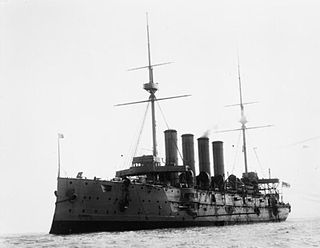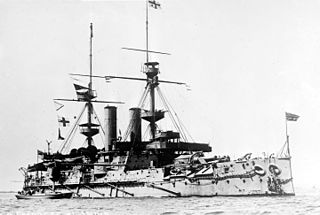
HMS Camperdown was an Admiral-class battleship of the Royal Navy, named after Adam Duncan, 1st Viscount Duncan of Camperdown.

HMS Hawke, launched in 1891 from Chatham Dockyard, was the seventh Royal Navy warship to be named Hawke. She was an Edgar-class protected cruiser.
HMS Griffon was a B-class torpedo boat destroyer of the British Royal Navy. She was completed by Laird, Son & Company, Birkenhead, in 1896.

HMS Repulse was one of seven Royal Sovereign-class pre-dreadnought battleships built for the Royal Navy in the 1890s. Assigned to the Channel Fleet, where she often served as a flagship, after commissioning in 1894, the ship participated in a series of annual manoeuvres, and the Queen Victoria's Diamond Jubilee Fleet Review during the rest of the decade. Repulse was transferred to the Mediterranean Fleet in 1902 and remained there until December 1903, when she returned home for an extensive refit. After its completion in 1905, Repulse was assigned to the Reserve Fleet until she was sold for scrap in 1911.

HMS Hannibal was a Majestic-class pre-dreadnought battleship built for the Royal Navy, and the sixth ship to bear the name HMS Hannibal. The ship was laid down at the Pembroke Dock in May 1894, she was launched in April 1896, and commissioned into the fleet in April 1898. She was armed with a main battery of four 12-inch (305 mm) guns and a secondary battery of twelve 6-inch (152 mm) guns. The ship had a top speed of 16 knots.

HMS Diadem was the lead ship of the Diadem-class of protected cruiser in the Royal Navy.

HMS Amphitrite was a ship of the Diadem-class of protected cruisers in the Royal Navy, which served in the First World War.

HMS Andromeda was one of eight Diadem-class protected cruisers built for the Royal Navy in the 1890s. Upon completion in 1899, the ship was assigned to the Mediterranean Fleet where she helped to escort a royal yacht during its cruise through the Mediterranean Sea. After a refit, she was assigned to the China Station in 1904 and returned home three years later to be reduced to reserve. Andromeda was converted into a training ship in 1913 and remained in that role under various names until 1956. That year she was sold for scrap and broken up in Belgium, the last Pembroke-built ship still afloat.

HMS Ariadne was a Diadem-class protected cruiser of the Royal Navy, which was launched in 1898, In March 1913, she was converted to a stokers' training ship and in 1917 was converted to a minelayer and assigned to the Nore Command. She was torpedoed and sunk off Beachy Head by the German submarine UC-65 on 26 July 1917.

HMS Terrible was the second and last of the Powerful-class protected cruisers built for the Royal Navy (RN) in the 1890s. She served on the China Station and provided landing parties and guns which participated in the Siege and Relief of Ladysmith in the Second Boer War in South Africa. A few months later she did much the same thing to help suppress the Boxer Rebellion in China. During this time, her captain was Percy Scott, who trained his crew to a high standard in gunnery and had his training methods adopted by the entire Royal Navy.

HMS Windsor Castle was a triple-decker, 102-gun first-rate Royal Navy ship of the line. She was renamed HMS Cambridge in 1869, when she replaced a ship of the same name as gunnery ship off Plymouth.

HMS Empress of India was one of seven Royal Sovereign-class pre-dreadnought battleships built for the Royal Navy during the 1890s. The ship was commissioned in 1893 and served as the flagship of the second-in-command of the Channel Fleet for two years. She was transferred to the Mediterranean Fleet in 1897, during which time Empress of India was assigned to the International Squadron blockading Crete during the uprising there. She returned home in 1901 and was briefly assigned as a coast guard ship in Ireland before she became the second flagship of the Home Fleet. The ship was reduced to reserve in 1905 and accidentally collided with the submarine HMS A10 the following year. Empress of India was taken out of service in early 1912 and accidentally struck a German sailing ship while under tow. She was sunk as a target ship in 1913.

HMS Amphion was a second-class cruiser of the Leander class which served with the Royal Navy. She was built at Pembroke Dockyard, being laid down in 1881, launched in 1883, and completed in financial year 1885–86, and then lay in ordinary at Devonport. She was commissioned for the 1887 and 1888 annual manoeuvres. She was recommissioned in December 1888. served in the Pacific until 1890, in the Mediterranean from 1890 to 1895, in ordinary in Devonport from 1895 to 1897 and in the Pacific once more from 1897 to 1904, having a refit in 1900.

HMS Fisgard was a 46-gun fifth rate Leda-class frigate of the Royal Navy. She spent sixty years in service on a variety of duties.

HMS Prometheus was a Pelorus-class protected cruiser of the Royal Navy. Ten sister third class protected cruisers were built — designed by Sir William White. While well-armed for their size, they were primarily workhorses for the overseas fleet considered to be on police duties. She was sold for scrap in 1914.

HMS Cambrian was a second-class protected cruiser, of the Royal Navy, built at the Pembroke Dockyard and launched on 30 January 1893. She was the last flagship of the Australia Station.

HMS Cynthia was a two funnel, 30-knot destroyer ordered by the Royal Navy under the 1896 – 1897 Naval Estimates. She was the third ship to carry this name. She was launched in 1898, served in home waters and the Mediterranean before World War I, and as a tender to the gunnery school at Sheerness during the war. She was sold for breaking in 1920.

HMS Albatross was an experimental torpedo boat destroyer of the Royal Navy authorised under the 1896–97 Naval Estimates and built by John I. Thornycroft & Company of Chiswick on the River Thames. She was contracted to be faster, larger and more powerful than existing designs.

Rear Admiral Burges Watson, was a Royal Navy officer who became Admiral Superintendent, Malta Dockyard.
Admiral Sir Frederic Edward Errington Brock, was a Royal Navy officer.


















